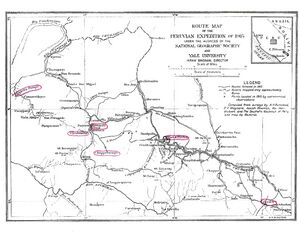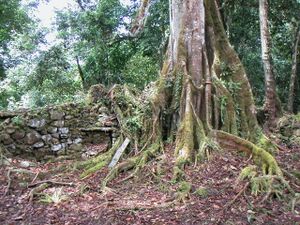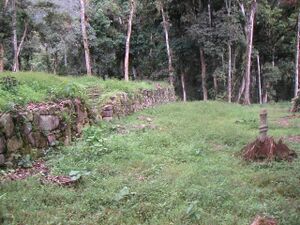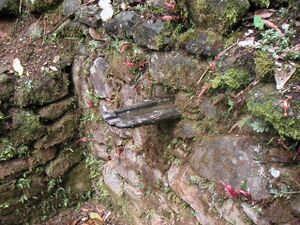ڤيلكابامبا، پيرو
Willkapampa | |
 Ruins of Espíritu Pampa | |
Location within Peru | |
| الاسم البديل |
|
|---|---|
| المكان | La Convención Province |
| المنطقة | Cuzco Department |
| الإحداثيات | 12°54′14″S 73°12′11″W / 12.904°S 73.203°W |
| الارتفاع | 1,458 m (4,783 ft) |
| النوع | Settlement |
| التاريخ | |
| الباني | Manco Inca Yupanqui |
| تأسس | 1539 |
| هـُـجـِر | 1572 |
| الثقافات | Neo-Inca State |
Vilcabamba (in Hispanicized spelling) or Willkapampa (Aymara[1] and Quechua)[2][3][4][5] is often called the Lost City of the Incas. Vilcabamba means "sacred plain" in Quechua.[6] The modern name for the Inca ruins of Vilcabamba is Espiritu Pampa (Plain of the Spirits). Vilcabamba is located in Echarate District of La Convención Province in the Cuzco Region of Peru.[7]
Vilcabamba was the capital of the Neo-Inca State from 1539 to 1572. The Neo-Inca State was the last refuge of the Inca Empire until it fell to the Spaniards and their indigenous allies in 1572, signaling the end of Inca resistance to Spanish rule. Subsequently, Vilcabamba was abandoned and its location forgotten. In 1911 explorer Hiram Bingham mistakenly identified the abandoned ruin of Machu Picchu as Vilcabamba, but he also visited a ruin called Espiritu Pampa by local Peruvians. In 1964, Gene Savoy identified Espiritu Pampa as the fabled Vilcabamba, a designation widely accepted by archaeologists and historians.[8]
Vilcabamba or Espiritu Pampa is located near the Chontabamba River, a tributary of the Urubamba River.[9] The Inca capital has often been referred to as Vilcabamba the Old to distinguish it from the town of Vilcabamba the New, of Spanish origin and 35 kilometres (22 mi) in straight-line distance southwest of Old Vilcabamba.[10][11]
In 2010, items belonging to the Wari culture and radiocarbon dated to about 700 CE were found at Espiritu Pampa. This discovery indicated that the site was occupied long before it became the Inca capital in 1539. As of 2013, archaeological investigations of the site were incomplete and the ruins of Espiritu Pampa were inaccessible by vehicle.[12]
. . . . . . . . . . . . . . . . . . . . . . . . . . . . . . . . . . . . . . . . . . . . . . . . . . . . . . . . . . . . . . . . . . . . . . . . . . . . . . . . . . . . . . . . . . . . . . . . . . . . . . . . . . . . . . . . . . . . . . . . . . . . . . . . . . . . . . . . . . . . . . . . . . . . . . . . . . . . . . . . . . . . . . . .
History
La Convención province in which Vilcabamba is located is extremely rugged, occupying the north-eastern slopes of the Andes and sloping down to the Amazon Basin. The terrain includes snow-covered mountains, forest, lowland jungle, and rivers running through deep canyons. Access and transportation within the area was difficult and would hinder Spanish efforts to destroy the last outposts of the Inca Empire.[13]
The Incas had occupied the Vilcabamba region since about 1450 CE, establishing major centers at Machu Picchu, Choquequirao, Vitcos, and Vilcabamba.[14] Thus, the Incas were familiar with the region when Inca emperor, Manco Inca Yupanqui, won the Battle of Ollantaytambo against the Spanish and their Indian allies in January 1537. Despite the victory Manco was under intense pressure from the Spanish. He decided that Ollantaytambo was too close to Cusco, controlled by the Spanish, so he withdrew westward to the Inca center of Vitcos. Almagro sent his lieutenant Rodrigo Orgóñez in pursuit with 300 Spaniards and numerous Indian allies. In July 1537, Orgoñez occupied and sacked Vitcos taking many prisoners, but Manco escaped.[15]
Manco Inca survived another Spain raid in 1539 by Gonzalo Pizarro, 300 Spanish soldiers, and Indian allies. The Spanish and the Incas fought a battle at Huayna Pukara (Huayna Fort), west of Vitcos and about 22 kilometres (14 mi) from Vilcabamba. Several Spaniards and Indians were killed, but Manco again escaped. Pizarro stayed in the region for more than two months searching for Manco unsuccessfully, but capturing Manco's principal wife Cura Ocllo. The Spaniards wrote of the region that "great resources are needed to undertake a penetration of that land. It can be done only with very heavy expenditure." The Spanish would not attempt another major military expedition into Vilcabamba until 1572. As the two Spanish raids demonstrated, Vitcos was accessible to the Spanish and Manco developed Vilcabamba as a more remote refuge.[16]
In the years following the Spanish raids, the Incas and the Spaniards maintained uneasy diplomatic relations with visits back and forth between Vilcabamba and Cuzco, the Spanish capital. The murder of a Spanish envoy by the Incas persuaded Viceroy of Peru Francisco de Toledo to conquer the Vilcabamba region and end Inca rule. On June 24, 1572, a Spanish army, led by veteran conquistador Martin Hurtado de Arbieto, made a final advance on the Incas' remote jungle capital. "At 10 o'clock," wrote Hurtado in his account of the campaign, "they marched into the city of Vilcabamba, all on foot, for it is the most wild and rugged country, in no way suitable for horses." What they discovered was a city built "for about a thousand fighting Indians, besides many other women, children, and old people" filled with "four hundred houses."[17]
After the fall of Vilcabamba, the Spanish pursued and captured Túpac Amaru, the last Inca monarch, and beheaded him in Cusco on September 24, 1572.[18]
Spanish Vilcabamba
In 1572, the conqueror and governor of Vilcabamba, Martin Hurtado de Arbieto, founded San Francisco de la Victoria de Vilcabamba, also known as Vilcabamba la Nueva ("the New"), 5 kilometres (3.1 mi) west of Vitcos. It is located on the Pampaconas River, a tributary of the Vilcabamba River, which is a tributary of the Urubamba River.[10] Hurtado was a brutal administrator, offering encomiendas to Spanish soldiers and making the local Indians virtual slaves. Many of them died, or abandoned their homes and fled elsewhere. Silver deposits were discovered nearby and the town enjoyed a brief boom, although the production of the mines was meager and by the early 17th century Vilcabamba the New and the Vilcabama region was no longer of much interest to the Spanish.[19] Hiram Bingham visited the town in 1911, noting that, "Instead of Inca walls or ruins, Vilcabamba has three score solidly built Spanish houses...due to the prosperity of gold diggers, who came to work the quartz mines which were made accessible after the death of Tupac Amaru." Catholic clerics had built a church and a monastery in the town.[20]
The lost city
The location of the Incan Vilcabamba was forgotten during the 17th century by the few remaining inhabitants of the region. In 1710, an explorer, Juan Arias Diaz, found Choquequirao, 70 kilometres (43 mi) southwest of Vilcabamba, and identified it as the Incan capital.[21] Later historians and explorers identified Choquequirao as Vilcabamba. In 1909, Peruvian historian, Carlos A. Romero, debunked the claim that Choquequirao was Incan Vilcabamba based on his studies of writings by Spanish chroniclers of the 16th century. Romero identified the village of Puquiura as the site of Incan Vilcabamba.[22]
In 1911, Hiram Bingham was on the expedition which resulted in him bringing to a wider world attention the Incan ruin of Machu Picchu. Romero pointed him toward Puquiura as the site of Vilcabamba, and Bingham discovered there the ruins of Rosaspata. He correctly identified Rosaspata as the Incan Vitcos rather than Incan Vilcabamba. Drawn by rumors of another lost Inca ruin in the lowland forest, Bingham ignored tales of a hostile plantation owner and dangerous native peoples and proceeded onward. After a difficult three days of foot travel, he found the plantation. Its owner and the Asháninka or Campa indigenous peoples working there were friendly and helpful. They assisted him in cutting a trail through the jungle and two days later he found Inca ruins at a place called Espiritu Pampa. He found artificial terraces, stone houses, including a rectangular building 192 feet (59 m) long, a fountain, Inca pottery, and a stone bridge. But Bingham was running out of supplies and only spent a short time at Espiritu Pampa. Based on his brief observations, Bingham concluded that Machu Picchu was the Incan Vilcabamba. That opinion went largely unchallenged for 50 years.[23][24]

In 1964, Peruvian explorer Antonio Santander Caselli visited Espiritu Pampa and later claimed the discovery that Espiritu Pampa was the Incan Villabamba.[25] In the same month, American explorer Gene Savoy reached Espiritu Pampa. He discovered that Bingham had only seen a minor part of the ruin at Eremboni Pampa and that the main ruin of Espiritu Pampa was 700 yards (640 m) distant. Savoy found 50 or 60 houses and 300 houses at Espiritu Pampa. Savoy concluded that Espiritu Pampa was Vilcabamba, contradicting Bingham.[26] Savoy's 1970 book Antisuyo brought the site to even wider attention.
Researcher and author John Hemming also concluded the Espiritu Pampa was Incan Vilcabamba in his 1970 book The Conquest of the Incas. He cited contemporary Spanish and Inca accounts of Vilcabamba as evidence. Titu Cusi Yupanqui said that Vilcambamba had a "warm climate," unlike Vitcos which was in "a cold district." This statement is consistent with the elevation of the two places: 1,450 metres (4,760 ft) for Espiritu Pampa and 2,980 metres (9,780 ft) for Vitcos. Moreover, both the conqueror of Vilcabamba, Hurtado de Abierto, and chronicler Martín de Murúa cited the tropical crops--coca, cotton, and sugar cane—grown near Vilcabamba and that the city lay in a "hot country" unlike most Inca cities. The Inca preferred to live in the high, cool climate of the Andes. Hurtado also described Vilcabamba as being in a valley with "pastures for cattle," unlike Machu Picchu which is on a steep ridge. Finally, Hemming cited Spanish sources indicating that Vilcabamba was northeast of Vitcos—unlike Machu Picchu which is west of Vitcos. Thus, Bingham's claim that Machu Picchu was Incan Villabamba and other claims that Vitcos was Vilcabamba were discredited.[27]
In 1976, Professor Edmundo Guillén and Polish explorers Tony Halik and Elżbieta Dzikowska continued to explore the ruins at Espiritu Pampa. Before the expedition, Guillen visited a museum in Seville where he discovered letters from Spaniards, in which they described the progress of the invasion and what they found in Vilcabamba. Comparison between the letters' contents and the ruins provided additional proof of Espiritu Pampa as the location of Vilcabamba.
In 1981, the party of American explorer Gregory Deyermenjian reached and photographed parts of the site, soon thereafter generating a popular article concerning the site and its history.[28]
Later extensive archeological work by Vincent Lee, and especially his exhaustive study, his 2000 book Forgotten Vilcabamba, gave further and even more precise confirmation that has made Espíritu Pampa the definitively accepted site of the historical Vilcabamba.
On 16 June 2006, a museum in Cuzco[29] unveiled a plaque that commemorates the thirtieth anniversary of the 1976 Vilcabamba findings.
In popular culture
The lost city of Vilcabamba features in the educational computer game series The Amazon Trail, the Tomb Raider videogame and its remake Tomb Raider: Anniversary, and the books Evil Star and Necropolis by British thriller author Anthony Horowitz. Vilcabamba is also a playable place in the PlayStation 2 RPG Shadow Hearts: From the New World.
The second episode of Michael Wood's 2000 documentary series Conquistadors visits the site of Vilcabamba while telling the story of the fall of the Inca and retreat of Manco and his followers to the remote region as the last surviving remnant of the empire.
The city was the location of British writer Colin Thubron's 2002 novel, To the Last City, which was short-listed for the Man Booker Prize, and tells the story of a group of people who set off to explore the ruins of the Inca city[30] in what has been described as a "Heart of Darkness narrative" in a "Marquezian setting".
The science fiction story "Vilcabamba" (2010) by Harry Turtledove is a self-referential allegory of Vilcabamba as an alien invasion story set in the 22nd century.
An episode of the TV Series In Search of... (1976-1982) titled "Inca Treasures", highlights the expedition taken by professor Edmundo Guillén to explore the ruins of Vilcabamba.
Gallery
Edmundo Guillén and Elżbieta Dzikowska in the ruins of Vilcabamba, photo taken by Tony Halik in 1976
انظر أيضاً
References
- ^ Ludovico Bertonio, Transcripción del vocabulario de la lengua aymara (Spanish-Aymara dictionary): Willka - Adoratorio dedicado al Sol u otros ídolos. / El Sol como antiguamente decían y ahora dicen inti. Pampa - El campo o todo lo que está fuera del pueblo, ahora sea cuesta, ahora llano. +Todo lo bajo respecto de la mesa o poyo, la tierra llana.
- ^ Teofilo Laime Ajacopa, Diccionario Bilingüe Iskay simipi yuyayk'ancha, La Paz, 2007 (Quechua-Spanish dictionary): willka - s. Nieto, ta respecto del abuelo. / s. Dios menor en la teogonia incaica. pampa s. Campo. Lugar generalmente plano. Pampa. / s. Llanura. Terreno uniforme y dilatado, sin altos ni bajos pronunciados.
- ^ Diccionario Quechua - Español - Quechua, Academía Mayor de la Lengua Quechua, Gobierno Regional Cusco, Cusco 2005: willka - s. Hist. Idolo de este nombre. Icono o imagen que representaba la divinidad tutelar del valle que se extiende desde lo que hoy es La Raya –línea divisoria entre Cusco y Puno– hasta la montaña misma. (J.L.P.) || Apellido de origen inkaico. / s. Biznieto o biznieta. SINÓN: haway. || Linaje. || adj. Sagrado, divino, sacro.
- ^ Mariko Namba Walter,Eva Jane Neumann Fridman, Shamanism: An Encyclopedia of World Beliefs, Practices, and Culture, Vol. 1, p. 439 willka or vilca (Anadenanthera peregrina and Anadenanthera colubrina):
- ^ Bingham, Hiram III. (2002) The Lost City of the Incas. Centenary edition. New York:Sterling Publ. Co. p.155. (huilca a type of tree and pampa a lowland flat area)
- ^ MacQuarie, Kim (2007), The Last Days of the Incas, New York: Simon and Schuster, p. 445
- ^ "Mapa," [1], accessed 16 Jul 2019
- ^ Hemming, John (1970), The Conquest of the Incas, New York: Harcourt Brace Jovanovich, Inc., pp. 485-494
- ^ Lee, Vincent H. L. (2000). Forgotten Vilcabamba: final stronghold of the Incas. [Wilson, Wyo.]: Sixpac Manco Publications. ISBN 978-0-9677109-0-7.
- ^ أ ب Thomson, Hugh. (2001). The White Rock. An Exploration of the Inca Heartland. London: Orion Books Ltd. p.310.
- ^ Google Earth
- ^ Fonseca Santa Cruz, Javier and Bauer, Brian S. (2013) "Dating the Wari Remains at Espiritu Pampa (Vilcabamba, Cusco)," Andean Past: Vol. 11 , Article 12, pp. 113-114, [2], accessed 2 July 2019
- ^ Hemming, pp. 255, p. 331-332; Google Earth
- ^ Bauer, Brian S., Halac-Higashimori, Madeleine, and Cantarutti, Gabriel E. (2013), Voices from Vilcabamba: Accounts Chronicling the Fall of the Inca Empire, Boulder: University Press of Colorado, p. 4. Downloaded from Project MUSE.
- ^ Hemming, The conquest, pp. 222–225.
- ^ Bauer et al. (2013), pp. 5-6; Hemming, p. 255
- ^ Martin Hurdado de Arbieto, quoted in Hemming, pp. 433-434
- ^ Bauer et al. (2013), p. 16
- ^ Hemming, pp. 474-478
- ^ Bingham, pg. 157-158
- ^ Ethan Todras-Whitehill in the New York Times
- ^ Hemming, pp. 478-481
- ^ Hemming, pp. 485-491
- ^ Bingham, pg. xxxv, xxxvi, 155-172, 197
- ^ Bauer, Brian S., Fonseca Santa Cruz, Javier, Araoz Silva, Miriam (2014), Vilcabamba and the Archaeology of Inca Resistance, Bristol, Connecticut: LLC, p. 24
- ^ Hemming, pp. 492-494
- ^ Hemming, pp. 492-499
- ^ Deyermenjian, Gregory. (1985). "Vilcabamba Revisited" in South American Explorer, No. 12.
- ^ "Museo Inka - UNSAAC". museoinka.unsaac.edu.pe. Archived from the original on 2017-02-14.
- ^ McCrum, Robert (July 28, 2002). "Back to the heart of darkness". The Guardian. London. Archived from the original on October 12, 2008. Retrieved May 27, 2010.
Sources
- Deyermenjian, Gregory. (1985). "Vilcabamba Revisited" in South American Explorer, No. 12.
- Hemming, John (1970). The conquest of the Incas. New York: Harcourt Brace Jovanovich. ISBN 978-0-15-602826-4.
- Lee, Vincent R. (2000). Forgotten Vilcabamba: final stronghold of the Incas. [Wilson, Wyo.]: Sixpac Manco Publications. ISBN 978-0-9677109-0-7.
- Macquarrie, Kim (2007). The last days of the Incas. New York: Simon Schuster. ISBN 978-0-7432-6049-7.
- Santander Casselli, Antonio (no date) "Vilcabamba" in Andanzas de un Soñador.
- Savoy, Gene. Antisuyo : the search for the lost cities of the Amazon / Glen Savoy. New York, Simon and Schuster [1970]. ISBN 978-0-671-20220-0.
- Waisbard, Simone (1979). The Mysteries of Machu Picchu. New York: Avon Books. ISBN 0-380-43687-6.
. . . . . . . . . . . . . . . . . . . . . . . . . . . . . . . . . . . . . . . . . . . . . . . . . . . . . . . . . . . . . . . . . . . . . . . . . . . . . . . . . . . . . . . . . . . . . . . . . . . . . . . . . . . . . . . . . . . . . . . . . . . . . . . . . . . . . . . . . . . . . . . . . . . . . . . . . . . . . . . . . . . . . . . .
للاستزادة
- Diego de Castro Yupangui (1992) [1570]. Instrucción al Licenciado Lope García de Castro. Colección Clásicos peruanos (in الإسبانية). Lima: Fondo Editorial.
- Laurence Blair (2018). Peru’s last Incan city reveals its secrets: ‘It’s genuinely a marvel’. Espíritu Pampa: TheGuardian.com
- Pages using gadget WikiMiniAtlas
- Short description is different from Wikidata
- Articles with hatnote templates targeting a nonexistent page
- Coordinates on Wikidata
- CS1 الإسبانية-language sources (es)
- مواقع أثرية في پيرو
- 16th-century establishments in the Inca civilization
- 16th-century disestablishments in the Inca civilization
- 1572 establishments in the Spanish Empire
- 1892 archaeological discoveries
- Former populated places in Peru
- History of Peru
- إنكا
- Lost cities and towns
- Populated places established in 1539
- Archaeological sites in Peru






